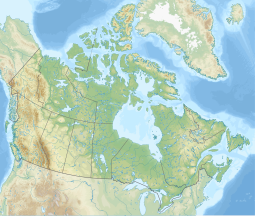| Chase River Kulwulton | |
|---|---|
| Location | |
| Country | Canada |
| Province | British Columbia |
| Physical characteristics | |
| Source | Mount Benson |
| Mouth | |
• location | Nanaimo Harbour |
• coordinates | 49°08′10″N 123°55′09″W / 49.13611°N 123.91917°W |
• elevation | 0 m (0 ft) |
Chase River[1] is a river on Vancouver Island in the Canadian province of British Columbia. It discharging into the Strait of Georgia at the south end of Nanaimo Harbour. It is the namesake of the city of Nanaimo's neighbourhood of Chase River.
River's course
The source of Chase River is on the south-west side of Mount Benson. From there it travels in an eastwardly direction towards Nanaimo, where it goes through Colliery Dam Park and the neighbourhoods of Harewood and Chase River before emptying into Nanaimo Harbour in the Nanaimo River estuary.[2]
History
In the winter of 1852–53, a Scottish shepherd, Peter Brown, was killed by two natives, one from Cowichan the other from Snuneymuxw. The Snuneymuxw man, hearing that the governor and troops would be hunting him, fled. He was easily tracked and captured because of the fresh-falling snow making his tracks easy to find and follow. The "chase" ended at this river.
They were tried on the ship SS Beaver on 17 January 1853 and hung the same day at Execution Point[3] on Douglas Island.[4] Execution Point got its name from those hangings. It was renamed in 1960 to Gallows Point[5] and Douglas Island was renamed Protection Island.
Colliery Dam Park
In 1910-1911, a series of dams were built by the along the river by the Western Fuel Company to supply water to the miners for coal washing. As a secondary use, homes near the water pipeline were allowed to use the water for domestic purposes. Eventually, most of the water for South Harewood received its water from this source. The city of Nanaimo turned this area into a park with swimming, walking trails, and picnicking.[6]
Chase River Fault
The Chase River Fault, a strike-slip tectonic fault line bisects the park, along the path of the Chase River and the reservoirs that make up the Colliery Dam.[7][8][9] Evidence of the fault in the form of striking fissure crevasses and chasms can be seen in several locations within and around the park. One such chasm known to locals simply as The Abyss, located about 1 kilometre (0.62 mi) from Upper Colliery Dam, has become a popular destination for tourists, hikers, and geologists.[10][11][12]
See also
References
- ^ BC Names/GeoBC entry "Chase River (river)"
- ^ Government of Canada, Natural Resources Canada. "Place names - Chase River". www4.rncan.gc.ca.
- ^ "From hangings to hauntings". 3 July 2014.
- ^ Government of Canada, Natural Resources Canada. "Place names - Protection Island". www4.rncan.gc.ca.
- ^ Government of Canada, Natural Resources Canada. "Place names - Gallows Point". www4.rncan.gc.ca.
- ^ "Colliery Dam Park | City of Nanaimo".
- ^ Doe, Nick (21 January 2012). "Gabriola's shape — including some surmises" (PDF). nickdoe.ca. Archived (PDF) from the original on 17 June 2022. Retrieved 17 June 2022.
- ^ Seward, Toby (8 July 2015). "Colliery Dams, Nanaimo BC, Lower Dam - Development of Design Alternatives" (PDF). City of Nanaimo. Archived (PDF) from the original on 23 June 2022. Retrieved 23 June 2022.
- ^ Bickford, Corilane (23 March 1993). "Geology and Petrography of the Wellington Seam, Nanaimo Coalfield, Vancouver Island" (PDF). University of British Columbia. Archived (PDF) from the original on 27 February 2020. Retrieved 15 June 2022.
- ^ Nanaimo, Tourism (15 January 2020). "A Local's Guide To The Abyss & Extension Ridge Trail". Tourism Nanaimo. Retrieved 23 June 2022.
- ^ Parcher, Kim (1 April 2021). "The Abyss and Hidden Labyrinth in Nanaimo". Vancouver Island View. Retrieved 23 June 2022.
- ^ White, Stephanie (2 August 2020). "BC Has A Hidden Abyss Where The World Splits In Two". Narcity. Vancouver BC. Archived from the original on 23 June 2022. Retrieved 23 June 2022.


